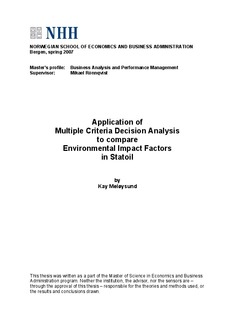Application of multiple criteria decision analysis to compare environmental impact factors in Statoil
Master thesis
Permanent lenke
http://hdl.handle.net/11250/167763Utgivelsesdato
2007Metadata
Vis full innførselSamlinger
- Master Thesis [4372]
Sammendrag
In this study, Multiple Criteria Decision Analysis (MCDA) is applied to the risk assessment
framework of Environmental Impact Factors (EIFs) in Statoil. The objective for the
application is to integrate EIFs to an indicator for overall environmental risk related to
emissions and discharges from petroleum activities and operations. To reach this indicator,
expert judgements of the relative importance of environmental compartments are considered
to be essential. The study is a part of the integrated HSE risk management project at Statoil
and is based on the principles and experiences from the MCDA trial session in 2006.
To further investigate and refine the approach, the case study of drilling technology
alternatives at the Norne field is applied. The Statoil goals of zero harm to the environment
and continuous improvement of environmental performance form the basis of the problem
design. Five decision alternatives are identified and relevant EIF scores for these alternatives
are assembled or estimated. The EIFs are tailored to act as decision criteria that reflect the
needs of scientific accuracy and practical viability, and the scores are accordingly modified.
The special features of the EIF for air emissions require a different approach for this factor.
For each alternative, criteria scores at the compartment level are aggregated and weighted
through the use of an optimisation model, and a total performance indicator for each
alternative is identified. Even though the EIF scores are calculated on the basis of generic
data, the area-specific sensitivity of environmental compartments results in importance
weights that are limited to a pre-defined area. The set of weights for the relevant influence
area in the Norne case is elicited through two expert panel sessions.
As a response to challenges at the first session, the problem design is additionally modified.
The most important adjustments are related to weight elicitation on a unit basis and the
introduction of “risk scores”. Due to similarity of data in the Norne case and a temporarily
exclusion of air emissions, three decision alternatives are identified as equally optimal. The
results from the second session indicate that the current problem design has increased the
feasibility of the MCDA approach, but that challenges like integration of air emissions and
relevance of sensitivity aspects remain.
